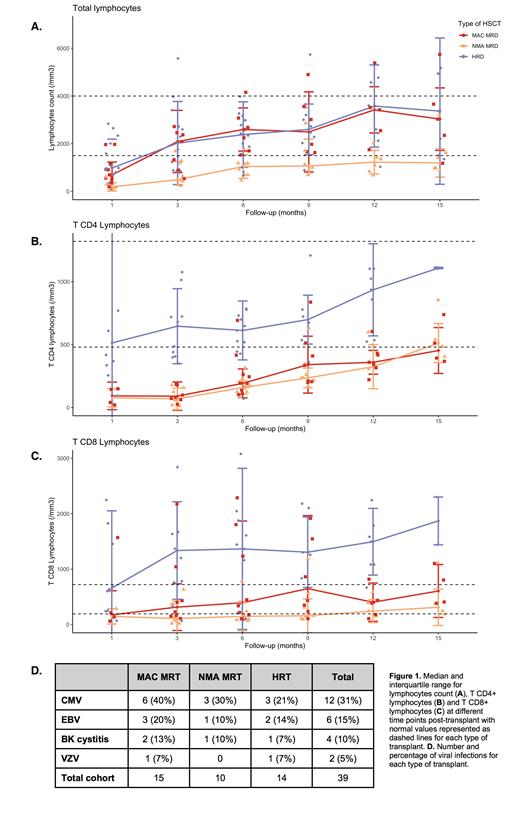Abstract
Introduction
Allogeneic hematopoïetic stem cell transplantation (HSCT) is the only established curative therapy for patients (pts) with sickle cell disease (SCD). It is mostly performed in children 1, due to higher risk of graft-versus-host disease (GVHD) and transplant related mortality in adults. Different approaches have been developped to improve tolerance of transplant in adults: use of reduced intensity conditioning (RIC) regimens 2 and intensive immunosuppression to avoid GVHD. Here, we have studied the impact of such approaches on immune reconstitution in adolescents and adults transplanted for SCD.
Patients and methods
We report 39 transplants in adolescents and adults, performed in Saint Louis hospital from 2008 to 2020: 25 were matched related transplants (MRT) and 14 haplo-identical related transplant (HRT). In MRT, conditioning was myeloablative (MAC) in 15 pts (busulfan, cyclophosphamide, rabbit anti-thymoglobulin (ATG) 20 mg/kg) and non myeloablative (NMA) in 10 pts (alemtuzumab 1 mg/kg, 3 Gy total body irradiation (TBI)). In MAC transplants, stem cell source was bone marrow and post-transplant immunosuppression was methotrexate and cyclosporine. In NMA transplants, stem cell source was peripheral blood cells with post-transplant immunosuppression by sirolimus. In the 14 HRT, the conditioning was reduced (cyclophosphamide, thiotepa, fludarabine, 2 Gy TBI, ATG 4.5 mg/kg), stem cell source was bone marrow and GVHD prophylaxis was ensured by post-transplant cyclophosphamide (100 mg/kg), sirolimus and mycophenolate mofetil.
Results
Median age at transplant was 17 years (y) old (range (r) 14-39). With a median follow-up of 3.6 y, the 2-y overall survival and survival without SCD were 97% (IC95%: 0.92-1) and 92% (IC95%: 0.83-1) respectively: no event after MRT, 1 death of GVHD and 2 graft rejections after HRT. The acute GVHD grade II-IV rate was 33%: 21% after HRT, 13% after MAC MRT and 0% after NMA MRT. Chronic GVHD occured in 3 pts (8%): severe in 1 HRT and mild in 2 MAC MRT. At 6 months, the blood chimerism evaluated in the 36 patients alive without rejection, was more often mixed (5 to 95% of donor) after NMA MRT (100%) versus MAC MRT (40%, p = 0.003) and HRT (18%, p < 0.001).
Total lymphocytes (TL) counts increased rapidly in HRT and MAC MRT with a normalization from 3 months post-transplant. In contrast, NMA MRT experienced a slower recovery: at 6 months, median count was 1039/mm3 (r 463-1767) compared to 2071/mm3 (r 882-5985, p = 0.002) after MAC MRT and 2382/mm3 (r 676-3978, p = 0.005) after HRT. After NMA MRT, TL counts remained lower than normal values up to 12 months with a median of 1195/mm3 (r 870-3210) (Figure 1A).
HRT displayed a rapid normalization of CD4 counts with a 3-month median count of 645/mm3 (r 350-1076) higher than reported after MRT (p < 0.001). Evolution of CD4 counts was similar after NMA and MAC MRT. They were lower than normal values during the first 12 months: median 364/mm3 and 388/mm3 respectively at 12 months (p = 0.25) (Figure 1B).
From 3 months post-transplant, CD8 counts reached normal values after MAC MRT (314/mm3, r 108-2175) and were superior to normal after HRT (1335/mm3, r 66-4529), with a significant difference between HRT and MRT (p = 0.003). After NMA MRT, there was a trend for lower 3-month CD8 counts compared to MAC MRT: median of 107/mm3 (r 18-631, p = 0.08). CD8 counts remained under normal values after NMA MRT up to 12 months post-transplant (Figure 1C).
From 3 to 6 months, CD4 and CD8 were mostly memory, with only 3.2% (r 0.1%-20.6%) and 6.2% (r 2.1%-11.2%) of CD45RA+ CCR7+ naïve CD8+ and CD4+ respectively.
In the 3 groups NK cell counts reached normal values after 3 months.
B lymphocytes counts normalized in the first months post-transplant except for patients who received rituximab for EBV reactivation. From 3 to 6 months, B lymphocytes were mostly naive: 98% of CD27- (r 92%-99%). Gammaglobuline levels were normal from 3 months in the 3 groups.
Twelve (31%) pts were treated for a CMV and 6 (15%) for an EBV reactivation. No patient had CMV or adenovirus disease, or post-transplant lymphoproliferative disorder. Infections according to transplant types are detailed in figure 1D.
Conclusion
NMA MRT were associated with a delayed CD4 and CD8 recovery probably due to alemtuzumab. As previously reported 3, HRT displayed a rapid immune reconstitution. Despite use of serotherapy in the three modalities of transplant, the rate of viral infections remained acceptable without severe episode.
Pondarré: ADDMEDICA: Honoraria. Peffault De Latour: Jazz Pharmaceuticals: Honoraria; Pfizer: Membership on an entity's Board of Directors or advisory committees, Other: Travel support, Research Funding; Amgen: Consultancy, Other, Research Funding; Alexion, AstraZeneca Rare Disease: Consultancy, Honoraria, Membership on an entity's Board of Directors or advisory committees, Other: Travel support, Research Funding. Boissel: CELGENE: Honoraria; Bristol-Myers Squibb: Honoraria, Research Funding; JAZZ Pharma: Honoraria, Research Funding; Incyte: Honoraria; Amgen: Consultancy, Honoraria, Research Funding; Novartis: Consultancy, Honoraria, Research Funding; Servier: Consultancy, Honoraria; SANOFI: Honoraria; PFIZER: Consultancy, Honoraria.


